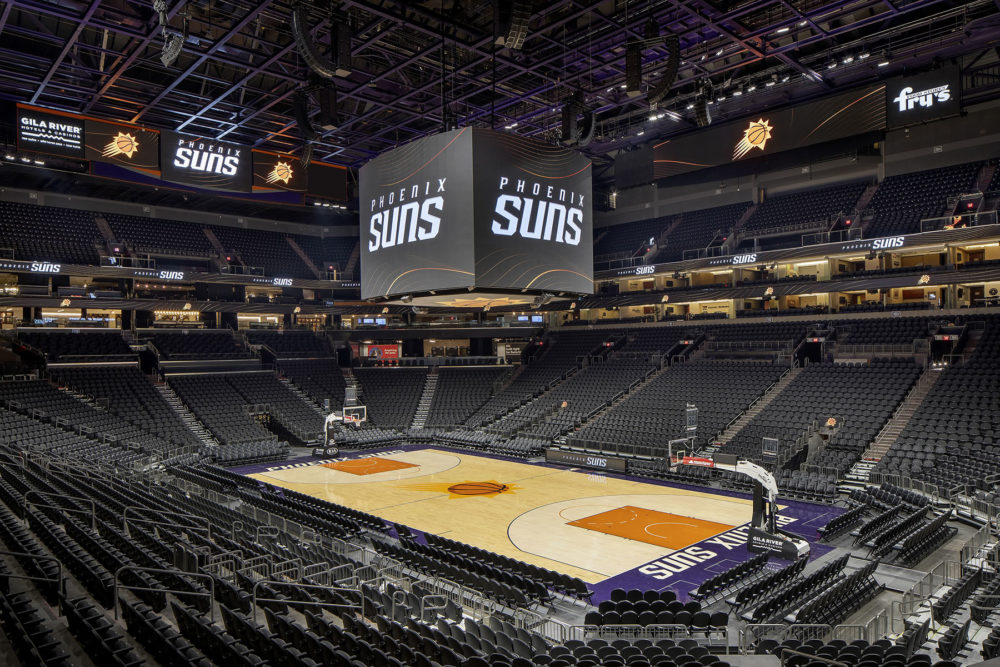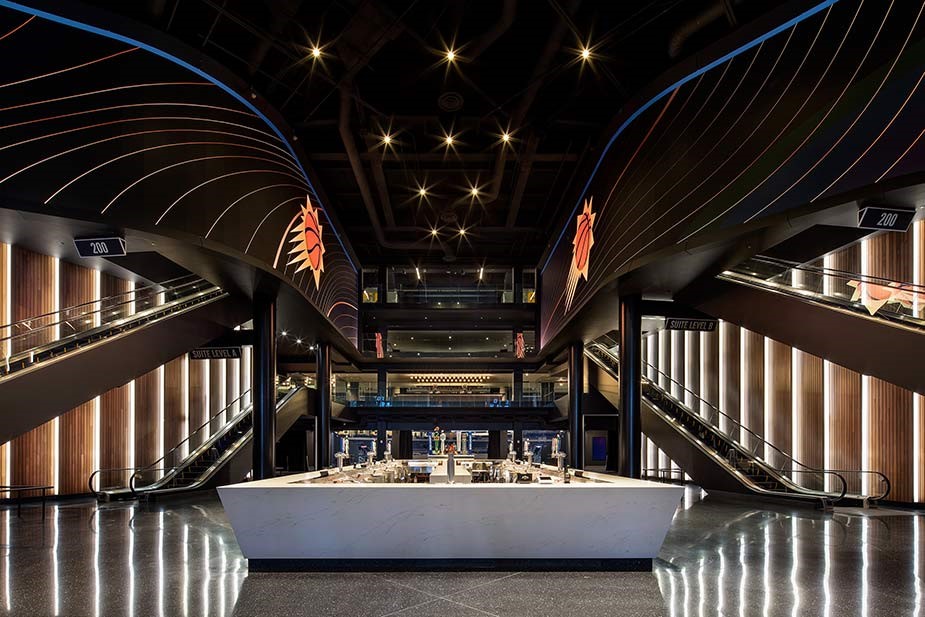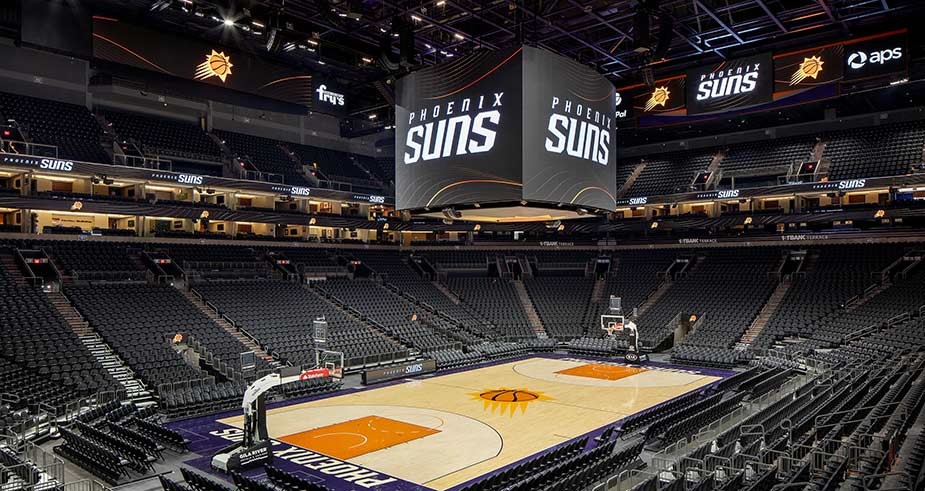It’s had multiple names since it first opened in June of 1992, but the Phoenix Suns Arena—formerly America West Arena, US Airways Center, Talking Stick Resort Arena, and PHX Arena—has been the home of the NBA’s Phoenix Suns since day one.
What has changed recently is how the venue sounds, with a new L-Acoustics Kara II loudspeaker system in place just in time for the 2020-2021 NBA season, which began with a Suns win over the Dallas Mavericks on Dec. 23, 2020.
Designed by AV consultants at WJHW and installed by Pro Sound & Video, a Solotech company, the new Kara II system is part of the $230 million Project 201: PHX Reimagined, designed to convert the nearly 30-year-old arena into a state-of-the-art sports entertainment venue for Phoenix Suns and WNBA Phoenix Mercury fans.
Related: Firehouse Productions Brings Live Energy to NBA Bubble
According to Pro Sound & Video, the arena’s management specifically requested an L-Acoustics PA system as part of the ongoing and extensive venue renovation, including new distributed sound systems for the arena’s concourses and back-of-house areas.
“We had to stay within certain weight limits on the steel for this project, especially since the system is designed to be pulled up and out of the way, potentially, when touring shows come through with their own sound systems,” said the Pro Sound staff.
“We worked very closely with the structural engineers to make sure we were well within the weight limits. At the same time, this is a large venue (18,000 capacity) and the sound needs to cover the entire seating area and court,” he said.
With the number of fans in attendance still being strictly limited per current safety protocols, acoustical reflection and reverberation issues from empty seating areas are a potential concern.
The Installation Story
Kara II has a “tight dispersion directivity and high degree of speech intelligibility,” said Pro Sound. “Those have become more and more important in sports venue sound designs and are reasons why L-Acoustics is seen in more arenas and stadiums.”
Phoenix Suns director of engineering and AV technology Gary Gillespie agrees, citing hearing L-Acoustics systems installed at the NFL Arizona Cardinals State Farm Stadium and NHL Arizona Coyotes Gila River Arena in nearby Glendale.
The arena’s new system comprises six arrays of 14 Kara II enclosures for a total of 84 Kara II, plus a hang of four SB18i subwoofers flown in a cardioid configuration directly behind each Kara II array. In addition, there are 28 short-throw X12 coaxials deployed as a delay ring.
All of these are powered by 43 LA4X amplified controllers—36 for the main PA and seven for the delays—providing over 170 channels of amplification. Furthermore, a single LA12X powers eight A10 loudspeakers positioned underneath the center-mounted scoreboard serving as court fills.
Self-powered, coaxial 108P monitors are also installed in the new media editing suite to replicate the response of the Kara II main bowl system for accurate media reproduction.
The design of the Phoenix Suns’ new sound system originally called for eight hangs of Kara. However, this was changed to accommodate revised weight-load requirements for touring systems. With last year’s addition of Panflex to the original Kara loudspeaker model, providing four-in-one directivity, Kara II was a “game-changer” for the Suns.
Now, one box could cover any audience geometry and offer consistent coverage and SPL distribution with precise focus in four different directivity patterns: 70 degrees or 110 degrees symmetrical and 90 degrees asymmetrical, focusing directivity to either the left or right.
In its 70-degree configuration, Kara II packs a full 2 dB more than in 110 degrees. That prompted design changes that allowed just six arrays to fulfill the coverage requirements of the bowl without having to alter the product specification from Kara II.
L-Acoustics Soundvision 3D modeling software was used to execute the system design and all revisions quickly and accurately.
This particular revision provided the venue with 28 additional Kara II from the original order that Gillespie and the Phoenix Suns management team decided would serve as onsite production inventory and be used as a multi-use, in-house special-events production audio system.
Those extra Kara II enclosures came in very handy almost immediately after the NBA directed their teams to implement their own enhanced crowd-noise systems for the current season.
The additional inventory, plus eight more enclosures rented from Clearwing Productions, now make up six hangs of six Kara II and are dedicated to the virtual crowd-noise system developed by Firehouse Productions for the NBA’s Orlando “bubble” last season, now at most NBA venues.
“We began to see ROI right away on what we had thought would be extra inventory,” said Gillespie. “With up to 3,000 fans allowed inside now, the system truly makes it sound like a full house.”
Inside Phoenix Suns Arena
Those fans inside the arena also see a new 18-display LED Daktronics system totaling 55.1 million LEDs, including a new center-hung configuration as well as lobby, ribbon, tunnel, scorer’s table and locker room displays. The installation was completed in time for the 2020-2021 season.
“Daktronics has been instrumental in the significant transformation at the reimagined Phoenix Suns Arena,” said Phoenix Suns president and CEO Jason Rowley. “Our fans will be surrounded by remarkable technology that will truly elevate the fan experience at every turn.”
The center-hung video board, which is six times larger than its predecessor, features four LED video displays, two facing the sidelines and two facing the ends of the arena. The sideline-facing displays each measure 25 feet high by 33 feet wide and the end-facing displays each measure 25 feet high by 29.5 feet wide.
All four feature 5.9-millimeter pixel spacing to bring crisp, clear imagery to fans in every seat of the arena. The entire center-hung features 3,100 square feet and it would take 292 60-inch televisions to cover the entire center-hung’s digital footprint.
“The fan experience at live events remains a crucial element for professional sports teams,” said Daktronics president and CEO Reece Kurtenbach. “This LED installation for Phoenix Suns Arena will bring fans a next-level experience and we’re excited to be a part of the reimagination of their arena.”
Two custom-shaped lobby displays combine for more than 6,700 square feet of digital space to welcome fans into the arena. One display measures approximately 26 feet high by 202 feet long and the other measures approximately 26 feet high by 113 feet long.
The height of each display fluctuates as they curve and wind their way into the main seating bowl. Both displays feature 3.9-millimeter pixel spacing to provide high-resolution imagery at close viewing distances.
“The Suns are catering to their fans in multiple locations outside of the main seating bowl as evidenced by their two new lobby displays,” said Kurtenbach. “As the fan experience spills out into the concourses and other gathering areas in event venues, adding technology to connect with audiences in those areas has become increasingly important to team and sponsor branding.
“This installation will be a great example of improving opportunities to connect with people in those areas,” he said.
Additionally, two ribbon displays are installed along the seating fascia totaling nearly 1,900 feet in length and six tunnel displays are installed above entrances to the seating bowl. Courtside, three LED scorer’s tables were also installed.
These displays allow the opportunity to highlight sponsors throughout events while providing supplement information and graphics to the center-hung displays.
The center-hung displays are capable of variable content zoning allowing each to share one large image or they can each be divided into multiple zones to show any variety of content including live video, instant replays, up-to-the-minute statistics and game information, graphics and animations, and sponsorship messages.
The Suns’ locker room and training facility each feature a display with 1.5-millimeter pixel spacing. These displays can be used to show replays of the action and to help with preparation for the game and the Suns’ current or upcoming opponent.
Daktronics also included its Show Control solution with this installation. This system provides a combination of display control software, world-class video processing, data integration and playback hardware that forms a user-friendly production solution.












